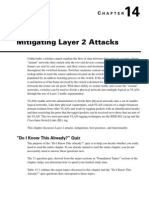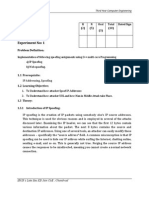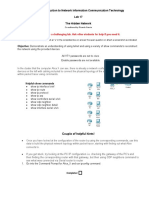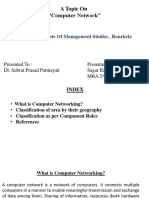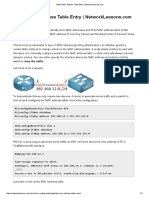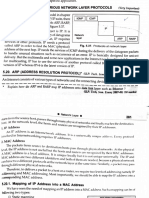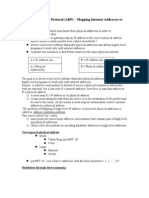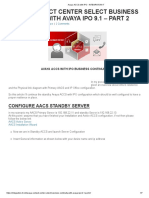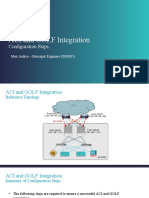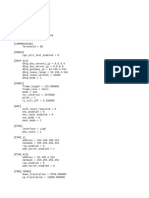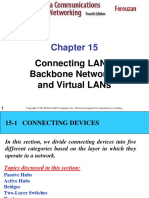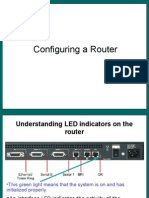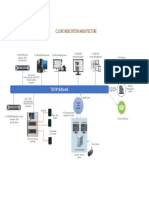Address Resolution Protocol
From Wikipedia, the free encyclopedia
Internet protocol suite
Application layer
BGP
DHCP
DNS
FTP
HTTP
IMAP
LDAP
MGCP
NNTP
NTP
POP
ONC/RPC
RTP
RTSP
RIP
SIP
SMTP
SNMP
SSH
Telnet
TLS/SSL
XMPP
more...
Transport layer
TCP
UDP
DCCP
SCTP
RSVP
more...
Internet layer
IP
IPv4
IPv6
ICMP
ICMPv6
ECN
IGMP
IPsec
more...
Link layer
ARP
NDP
OSPF
Tunnels
L2TP
PPP
MAC
Ethernet
DSL
ISDN
FDDI
more...
The Address Resolution Protocol (ARP) is a telecommunication protocol used for resolution
of network layeraddresses into link layer addresses, a critical function in multiple-access
networks. ARP was defined by RFC 826 in 1982,[1] is Internet Standard STD 37, and is also the
name of the program for manipulating these addresses in mostoperating systems.
ARP is used for mapping a network address (e.g. an IPv4 address) to a physical address like
an Ethernet address (also named a MAC address). ARP has been implemented with many
combinations of network and data link layer technologies, like IPv4, Chaosnet, DECnet and
Xerox PARC Universal Packet (PUP) using IEEE 802 standards, FDDI,X.25, Frame
Relay and Asynchronous Transfer Mode (ATM). IPv4 over IEEE 802.3 and IEEE 802.11 is the
most common case.
In Internet Protocol Version 6 (IPv6) networks, the functionality of ARP is provided by
the Neighbor Discovery Protocol(NDP).
Contents
[hide]
1Operating scope
2Packet structure
3Example
4ARP probe
5ARP announcements
6ARP mediation
7Inverse ARP and Reverse ARP
8ARP spoofing and Proxy ARP
9Alternatives to ARP
10ARP stuffing
11Standard documents
12See also
13References
14External links
Operating scope[edit]
The Address Resolution Protocol is a request and reply protocol that runs encapsulated by the
line protocol.[clarification needed] It is communicated within the boundaries of a single network, never
routed across internetwork nodes. This property places ARP into the Link Layer of the Internet
Protocol Suite,[2] while in theOpen Systems Interconnection (OSI) model, it is often described as
residing between Layers 2 and 3, being encapsulated by Layer 2 protocols. However, ARP was
not developed in the OSI framework.
Packet structure[edit]
The Address Resolution Protocol uses a simple message format containing one address
resolution request or response. The size of the ARP message depends on the upper layer and
lower layer address sizes, which are given by the type of networking protocol (usually IPv4) in
use and the type of hardware or virtual link layer that the upper layer protocol is running on. The
message header specifies these types, as well as the size of addresses of each. The message
header is completed with the operation code for request (1) and reply (2). The payload of the
packet consists of four addresses, the hardware and protocol address of the sender and receiver
hosts.
The principal packet structure of ARP packets is shown in the following table which illustrates the
case of IPv4 networks running on Ethernet. In this scenario, the packet has 48-bit fields for the
sender hardware address (SHA) and target hardware address (THA), and 32-bit fields for the
corresponding sender and target protocol addresses (SPA and TPA). Thus, the ARP packet size
in this case is 28 bytes. The EtherType for ARP is 0x0806. (This appears in the Ethernet frame
header when the payload is an ARP packet. Not to be confused with PTYPE below, which
appears within this encapsulated ARP packet.)
Internet Protocol (IPv4) over Ethernet ARP packet
octet
offse
Hardware type (HTYPE)
Protocol type (PTYPE)
Hardware address length (HLEN)
Protocol address length (PLEN)
Operation (OPER)
Sender hardware address (SHA) (first 2 bytes)
10
(next 2 bytes)
12
(last 2 bytes)
14
Sender protocol address (SPA) (first 2 bytes)
16
(last 2 bytes)
18
Target hardware address (THA) (first 2 bytes)
20
(next 2 bytes)
22
(last 2 bytes)
24
Target protocol address (TPA) (first 2 bytes)
26
(last 2 bytes)
Hardware type (HTYPE)
This field specifies the network protocol type. Example: Ethernet is 1.
Protocol type (PTYPE)
�This field specifies the internetwork protocol for which the ARP request is intended. For
IPv4, this has the value 0x0800. The permitted PTYPE values share a numbering space
with those for EtherType.[3][4][5]
Hardware length (HLEN)
Length (in octets) of a hardware address. Ethernet addresses size is 6.
Protocol length (PLEN)
Length (in octets) of addresses used in the upper layer protocol. (The upper layer
protocol specified in PTYPE.) IPv4 address size is 4.
Operation
Specifies the operation that the sender is performing: 1 for request, 2 for reply.
Sender hardware address (SHA)
Media address of the sender. In an ARP request this field is used to indicate the address
of the host sending the request. In an ARP reply this field is used to indicate the address
of the host that the request was looking for. (Not necessarily address of the host replying
as in the case of virtual media.) Note that switches do not pay attention to this field,
particularly in learning MAC addresses. The ARP PDU is encapsulated in Ethernet frame,
and that is what Layer 2 devices examine.
Sender protocol address (SPA)
Internetwork address of the sender.
Target hardware address (THA)
Media address of the intended receiver. In an ARP request this field is ignored. In an ARP
reply this field is used to indicate the address of the host that originated the ARP request.
Target protocol address (TPA)
Internetwork address of the intended receiver.
ARP protocol parameter values have been standardized
and are maintained by the Internet Assigned Numbers
Authority (IANA).[6]
Example[edit]
For example, the
computers Matterhorn and Washington are in an office,
connected to each other on the office local area
network by Ethernet cables and network switches, with no
intervening gateways or routers. Matterhorn wants to send
a packet to Washington. Through DNS, it determines that
Washington's IP address is 192.168.0.55. In order to send
the message, it also needs to know Washington's MAC
address. First, Matterhorn uses a cached ARP table to look
up 192.168.0.55 for any existing records of Washington's
MAC address (00:eb:24:b2:05:ac). If the MAC address is
found, it sends the IP packet encapsulated in a level
2 frame on the link layer to address 00:eb:24:b2:05:ac via
the local network cabling. If the cache did not produce a
result for 192.168.0.55, Matterhorn has to send a broadcast
ARP message (destination FF:FF:FF:FF:FF:FF MAC
address which is accepted by all computers) requesting an
answer for 192.168.0.55. Washington responds with its
MAC address (and its IP). Washington may insert an entry
for Matterhorn into its own ARP table for future use. The
response information is cached in Matterhorn's ARP table
and the message can now be sent.[7]
ARP probe[edit]
�An ARP probe is an ARP request constructed with an allzero sender IP address (SPA). The term is used in the IPv4
Address Conflict Detection specification (RFC 5227).
Before beginning to use an IPv4 address (whether received
from manual configuration, DHCP, or some other means), a
host implementing this specification must test to see if the
address is already in use, by broadcasting ARP probe
packets.[8]
ARP announcements[edit]
ARP may also be used as a simple announcement protocol.
This is useful for updating other hosts' mappings of a
hardware address when the sender's IP address or MAC
address has changed. Such an announcement, also called
a gratuitous ARP message, is usually broadcast as an ARP
request containing the senders protocol address (SPA) in
the target field (TPA=SPA), with the target hardware
address (THA) set to zero. An alternative is to broadcast an
ARP reply with the sender's hardware and protocol
addresses (SHA and SPA) duplicated in the target fields
(TPA=SPA, THA=SHA).
An ARP announcement is not intended to solicit a reply;
instead it updates any cached entries in the ARP tables of
other hosts that receive the packet. The operation code
may indicate a request or a reply because the ARP
standard specifies that the opcode is only processed after
the ARP table has been updated from the address fields.[9][10]
[11]
Many operating systems perform gratuitous ARP during
startup. That helps to resolve problems which would
otherwise occur if, for example, a network card was recently
changed (changing the IP-address-to-MAC-address
mapping) and other hosts still have the old mapping in their
ARP caches.
Gratuitous ARP is also used by some interface drivers to
provide load balancing for incoming traffic. In a team of
network cards, it is used to announce a different MAC
address within the team that should receive incoming
packets.
ARP announcements can be used to defend link-local IP
addresses in the Zeroconf protocol (RFC 3927), and for IP
address takeover within high-availability clusters.
ARP mediation[edit]
ARP mediation refers to the process of resolving Layer 2
addresses through a Virtual Private Wire Service (VPWS)
when different resolution protocols are used on the
connected circuits, e.g., Ethernet on one end and Frame
Relay on the other. In IPv4, each Provider Edge (PE)
device discovers the IP address of the locally
attached Customer Edge (CE) device and distributes that IP
address to the corresponding remote PE device. Then each
PE device responds to local ARP requests using the IP
�address of the remote CE device and the hardware address
of the local PE device. In IPv6, each PE device discovers
the IP address of both local and remote CE devices and
then intercepts local Neighbor Discovery (ND) and Inverse
Neighbor Discovery (IND) packets and forwards them to the
remote PE device.[12]
Inverse ARP and Reverse ARP[edit]
Inverse Address Resolution Protocol (Inverse ARP or
InARP) is used to obtain Network Layer addresses (for
example, IP addresses) of other nodes from Data Link
Layer (Layer 2) addresses. It is primarily used in Frame
Relay (DLCI) and ATM networks, in which Layer 2
addresses of virtual circuits are sometimes obtained from
Layer 2 signaling, and the corresponding Layer 3
addresses must be available before those virtual circuits
can be used.[13]
Since ARP translates Layer 3 addresses to Layer 2
addresses, InARP may be described as its inverse. In
addition, InARP is implemented as a protocol extension to
ARP: it uses the same packet format as ARP, but different
operation codes.
The Reverse Address Resolution Protocol (Reverse ARP or
RARP), like InARP, translates Layer 2 addresses to Layer 3
addresses. However, in InARP the requesting station
queries the Layer 3 address of another node, whereas
RARP is used to obtain the Layer 3 address of the
requesting station itself for address configuration purposes.
RARP is obsolete; it was replaced by BOOTP, which was
later superseded by the Dynamic Host Configuration
Protocol (DHCP).[14]
ARP spoofing and Proxy ARP[edit]
A successful ARP spoofingattack allows an attacker to
perform a man-in-the-middle attack.
Main article: ARP spoofing
Main article: Proxy ARP
Because ARP does not provide methods for authenticating
ARP replies on a network, ARP replies can come from
systems other than the one with the required Layer 2
address. An ARP proxy is a system which answers the ARP
request on behalf of another system for which it will forward
�traffic, normally as a part of the network's design, such as
for a dialup internet service. By contrast, in
ARP spoofing the answering system, or spoofer, replies to
a request for another system's address with the aim of
intercepting data bound for that system. A malicious user
may use ARP spoofing to perform a man-in-themiddle or denial-of-service attack on other users on the
network. Various software exists to both detect and perform
ARP spoofing attacks, though ARP itself does not provide
any methods of protection from such attacks.[15]
Alternatives to ARP[edit]
Each computer maintains its own table of the mapping
from Layer 3 addresses (e.g. IP addresses) to Layer
2 addresses (e.g. ethernet MAC addresses). In a modern
computer this is maintained almost entirely by ARP packets
on the local network and is thus often called the 'ARP
cache' as opposed to 'Layer 2 address table'. In older
computers, where broadcast packets were considered an
expensive resource, other methods were used to maintain
this table, such as static configuration files,[16] or centrally
maintained lists. Since at least the 1980s[17] networked
computers have had a command called arp for interrogating
or manipulating this table, and practically all modern
personal computers have a variant of this.[18][19][20]
ARP stuffing[edit]
Embedded systems such as networked cameras[21] and
networked power distribution devices,[22] which lack a user
interface, can use so-called ARP stuffing to make an initial
network connection, although this is a misnomer, as ARP is
not involved. This is a solution to an issue in network
management of consumer devices, specifically the
allocation of IP addresses of ethernet devices where 1) the
user doesn't have the ability to control DHCP or similar
address allocation protocols, 2) the device doesn't have a
user interface to configure it, and 3) the user's computer
can't communicate with it because it has no suitable IP
address.
The solution adopted is as follows: the user's computer has
an IP address stuffed manually into its address table
(normally with the arp command with the MAC address
taken from a label on the device) and then sends special
packets to the device, typically a ping packet with a nondefault size. The device then adopts this IP address, and
the user then communicates with it
by telnet or web protocols to complete the configuration.
Such devices typically have a method to disable this
process once the device is operating normally, as it is
vulnerable to attack.



















